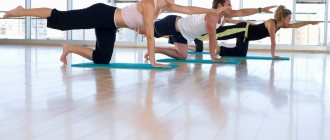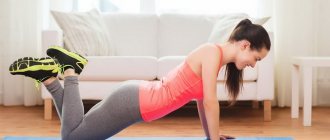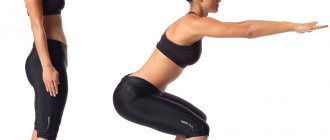Does yoga help you lose weight and get rid of belly fat?
Numerous studies confirm that yoga exercises for losing belly fat and sides are more effective than traditional gym workouts. Just half an hour a day of performing certain asanas can save you from 2.5 kg of excess weight per week. Exercises and meditation lead to a connection between mind and body, which allows you to intuitively switch to a healthy diet and give up unhealthy foods.
Benefits for the body
The exercise system helps to cope with excess weight in several ways:
- getting physical activity;
- acceleration of metabolism;
- formation of healthy eating habits.
As a result, you will certainly lose weight, although the desired goal will not be achieved as quickly as with fitness classes. There are other benefits to these workouts. Exercise will bring great benefits to the body:
- your posture will be straightened and your spine will be strengthened;
- heart function will improve;
- the immune system and lymphatic system will be strengthened;
- Digestion and intestinal function are normalized;
- pressure will decrease;
- muscle tension will be relieved.
Which yoga is best for weight loss?
The principle of losing weight with yoga exercises is based on the isometric effect on the muscles. Unlike power loads, muscle tissue is tense, but its length does not change. There are many practices that promote weight loss. You can choose any direction:
- Hatha. Classic variations of exercises based on a leisurely pace and calm performance of asanas. The load is comparable to strength training. There are 4 exercises in the basic complex. Learning asanas on your own from photos or videos from the Internet can be dangerous, so seek professional help from a trainer.
- Iyengar . For comfort and high efficiency of this system, various devices are used: rollers, belts, supports. All loads are static; when developing the complex, the individual characteristics of the student are taken into account.
- Ashtanga. During exercises from this system, it is important to achieve synchronization of breathing with movements. The result is internal heat and profuse sweating of the body. Increased oxygen supply ensures the accumulation of vital energy. The practitioner gains strength and lightness.
- Kundalini. The system includes meditations combined with movements. The classes have no contraindications; after regular training, the body will gain flexibility, mobility, and endurance. Additional benefits are increased resistance to stress, improved body function, increased awareness and self-discipline.
How does power yoga work for weight loss?
By working in strength mode, we form high-quality muscle mass. Muscles in the body not only perform motor function, they are also involved in thermoregulation and help the heart pump blood. The more you train your muscles, the better they cope with these functions.
Also, muscle loads contribute to the formation of the required amount of carbon dioxide in the body - its lack leads to vasoconstriction and, according to some experts, hypertension. Hypocapnia (a condition caused by a lack of CO2) affects people who lead a sedentary lifestyle and do not move much.
In addition, strength training promotes the production of somatropin and testosterone, hormones that promote the breakdown of fat. Thus, by forming high-quality muscle tissue, we will quickly get rid of fat deposits and gain a slim figure.
By the way, some girls avoid strength exercises because they do not want to pump up their muscles too noticeably. I mentioned why you shouldn’t be afraid of this in my article “Alena Mordovina: why you can’t lose weight ,” and Alexey Vasilenko wrote about this more than once ( “Alexey Vasilenko: “Don’t be afraid to pump up your muscles!” and “Alexey Vasilenko : “I am cheerful, cheerful and moderately jumpy! ”
I offer you a set of asanas to work out all muscle groups. Hold each pose until you feel a burning sensation in your muscles (but not less than 70 seconds) and another 10 seconds to achieve the desired effect.
Yoga at home
Yoga does not involve dynamic movements. In some asanas you need to move, in others you just need to stay in a certain position. It is important to follow all the rules of execution and monitor your breathing. For beginners, it can be difficult to independently assess the correctness of performing asanas, so it is recommended to contact a specialist who will teach the technique and select a complex based on the state of the beginner’s body.
For the abs and waist
To form an ideal figure, beautiful belly and sides, and maintain shape, you don’t have to exhaust yourself with strength training; take yoga asanas into your arsenal. Static exercises will help you form graceful body curves and strong abs:
- bar;
- Downward Facing Dog asana;
- Eagle pose;
- Twisted stomach;
- Setu Bandha Sarvangasana;
- Walking turtle.
For a flat stomach
This type of workout will help remove excess fat around your belly. One of the effective practices is healing self-massage. Warm up your hands by rubbing them together, then knead your sides and stomach in a clockwise circular motion. Massage 2-3 times a day to increase blood flow and speed up the fat burning process. Some of the current yoga exercises for losing weight on the stomach and sides include the following:
- Cobra pose;
- Pavanmuktasana;
- Bow pose;
- Uddiyana bandha.
For beginners
Overweight people who have never exercised will find it difficult to lose weight through cardio or strength training. Yoga will help strengthen your muscles even with the simplest exercises available to beginners. The main task is to focus on the correct execution technique, as well as breathing, in this case you can count on a good result.
Contraindications for yoga.
Like any other physical activity, yoga has its contraindications. Therefore, in some cases it is better to first consult a doctor. So, what are the warnings and contraindications that you need to inform the instructor about:
- hernias and protrusions;
- suffered a heart attack, stroke;
- diseases of the cardiovascular system;
- oncological diseases;
- serious injuries in the past, especially if they still bother you;
- joint injuries and diseases;
- menstrual period (read the article about the main contraindications these days).
All these contraindications do not mean that you cannot do yoga. You just need to be more careful when performing certain asanas, so your teacher needs to know about them in order to create the right program or adjust your practice in time.
Often yoga for weight loss is an active exercise; it is recommended to consult a doctor before starting, especially if you have any diseases, previous surgeries or injuries
Asanas
A common problem for women is a large belly. Certain exercises from Indian practices will help you make your figure slim and flexible. With daily training, the results will be visible within two weeks. Before starting your workout, be sure to warm up. Fixation in the asana is needed for 1 minute, but for beginners this period can be shortened. Perform each exercise at least 2 times.
Cobra pose
Starting position – lying on your stomach:
- Legs straight, brought together, feet extended.
- The arms are bent at the elbows, pointing upward, the hands are located under the shoulders.
- While inhaling, lift your body without resting on your palms, using your back muscles to move.
- Halfway up, inhale and exhale slowly twice.
- At the end of the lift, your arms should be straight. Pull your head and neck up, your chin should be directed towards your chest, and your buttock muscles should be tense.
- After two breathing cycles, exit the asana.
Downward facing dog
One of the popular yoga exercises for losing weight in the abdomen and sides is Downward Facing Dog asana. First you should do a warm-up, the end of which will be the child’s pose - Balasana. To perform Downward Facing Dog asana, after warming up, take a kneeling position as follows:
- Place your palms at shoulder level, open your fingers, and focus on their pads.
- keep your back straight, hips perpendicular to the floor;
- fix your feet, bend your toes, and your heels should look up, the outer ribs of your feet are parallel to each other;
- Point your face down, between your hands; your neck should not bend, continuing the line of your back.
From the position you need to move to the plank. To do this, bend your knees and pull your pelvis towards your heels. Keep your neck parallel to your spine. Place your fingertips on the floor with your fingertips apart. Take 1-2 steps forward. You should feel the tendons under your knees stretch. Relax your head between your hands and your body. Extend your legs as much as possible, placing your feet firmly on the floor and keeping your arms straight. The pelvic bones are directed upward. You need to stay in the asana for 30 seconds - 1 minute, breathe regularly.
Warrior Pose
Yoga for the abdomen, buttocks and thighs suggests the Warrior Pose exercise:
- To perform the asana, stand straight, then take a wide step back.
- When performing, the feet are firmly on the floor. You need to straighten your lower back, raise your arms up.
- Breathing remains even and calm all the time.
- Maintain the position for as long as you can stand it.
- You can make the task more difficult by turning your body to the left or right.
Dhanurasana – bow pose
To perform the exercise, you need to lie on your stomach and relax:
- Stretch your arms along your body.
- Inhale deeply, bend your knees, lift them and clasp your ankles with your hands.
- The pose resembles a drawn bow. Raise your head, chest and hips as high as possible, tense your back, leave your arms straight.
- You can hold your breath in this position or take slow and deep breaths. Maintain the asana for as long as possible.
- While exhaling, return to the starting position. Repeat the exercise 5 times.
Triangle
Stand up straight, draw in your stomach, tense your legs, and then:
- Inhale, spread your legs 1 meter wide, spread your arms to the sides parallel to the floor surface.
- Exhale, clasp your right shin with your right hand.
- Inhale and draw in your sides.
- Stretch your left arm up, while turning your head to the left. Hands are located on the same line.
- Turn your legs out: the right one completely, and the left one 45 degrees. Concentrate your gaze on your left palm.
- Stretch your spine and neck as much as possible. Hold the position for 30-60 seconds, then repeat on the other side.
Kumbhakasana
Classic yoga for the abs and waist includes plank pose or Kumbhakasana. To perform it, you need to press your palms to the floor shoulder-width apart and transfer your body weight to them. Stretch your legs, press your socks tightly to the surface. This position resembles a plank or standard push-up position. The body should be in the same plane, the back and legs straight.
Yoga for losing weight on the stomach and sides - physical exercises for beginners
- Stabilization in tree pose. Tree pose is a good asana to start with because it is not very difficult and allows you to focus on your breathing. All this time, the abdominal muscles, lateral abdominal muscles and lower back muscles will be toned in order to maintain balance on one leg.
Start in a standing position and shift your weight to your left leg. Bend your right knee and place your right foot on the inside of your left thigh. Find balance in this pose.
When you find your balance, raise your arms and place your palms in front of your chest in a namaste gesture. Focus your gaze on a point in front of you, this will help you maintain your balance. Breathe deeply. Stay in this position for 10 breaths, remembering to exhale deeply and completely.
- Do a yoga flow or vinyasa. Vinyasa usually consists of three poses that flow smoothly into each other in synchronization with breathing. Vinyasa tones all the major muscles of the body, including the core, abdominal and back muscles. That's what we need. Get on all fours, with your palms directly under your shoulders and your knees directly under your hip joints. Take a deep breath and, as you exhale, move into the downward-facing dog pose - straighten your arms and legs, lift your pelvis as high as possible, fingers spread, head hanging freely. This makes your body look like an inverted V. Hold this pose for 5 breaths. Press your palms and feet into the floor, push the mat forward with your hands and back with your feet, as if you want to tear it apart. Try to stretch your pelvis up, lengthening your spine.
Exhale and lower yourself into staff pose, which looks like a push-up at the bottom. As you inhale, smoothly transition into upward-facing dog pose. Hold for 5 breaths. As you exhale, move back into staff pose and hold it for 5 breaths. As you exhale, return to downward-facing dog pose. Repeat the entire flow 5 times.
- Toner your abs in boat pose. Boat pose tones and strengthens the abdominal muscles, as well as the muscles of the back, legs and arms. Add this pose to your yoga practice for a more effective workout.
Start by lying on your back. Keep your feet together, arms at your sides and take a deep breath. As you inhale, slowly raise your legs and torso, making sure that your abs are working, and not your back and neck. Pull your legs towards your toes. You can bend your legs at a 90-degree angle to make this exercise easier. Your body should be in a V shape. Hold for 10 deep breaths. Make sure your shoulders are down from your ears, your back is straight, and your chest is open.
- Add movement to Downward Facing Dog pose. This variation of the downward-facing dog pose is a great workout for the lower abdomen and helps tone the hard-to-reach muscles in this area.
In downward-facing dog, exhale and bend your right leg, bringing your knee toward your nose. As you inhale, return your leg to the starting position. As you exhale, repeat the same with your left leg. This is one cycle. Repeat the exercise 10 times.
- Plank. You may already be familiar with the plank. This is a standard exercise to strengthen your abdominal muscles. The plank is also the main yoga exercise for a flat stomach.
Start by lying on your stomach. Press your palms into the mat on either side of your shoulders and place your toes on the mat as well. Push with your hands to lift your body off the ground. Tuck your tailbone, stretch the top of your head forward. Stay in this pose for several breaths. When you're ready, simply lower yourself to the floor as you exhale. You can also add vinyasas, or movements, to this asana. Standing in a plank position with straight arms, alternately bend your knees, bringing your knee closer to your nose. This is similar to what we did in Downward Facing Dog. As you exhale, tighten your knee, and as you inhale, return to the starting position. Repeat 8-20 times, maintaining even breathing.
- Add side slats. From the plank position, you can move into the side plank position, which strengthens the obliques. These muscles are quite difficult to work, but this exercise tones them quite well.
Start in plank position. As you inhale, turn sideways to the floor, placing your right foot on top of your left and leaning on one hand. Your left arm should be directly under your left shoulder, so that your only support is the outer edge of your left foot and your left palm. If it’s hard, it’s fashionable to lean on your elbow and forearm. The right arm can be extended upward perpendicular to the floor. Hold this position for 10 breaths and then repeat on the other side.
Exercise technique
In order for classes to give excellent results in the form of weight loss, improved functioning of systems and organs, and improved mood, you must adhere to certain rules:
- training is carried out in a well-ventilated area;
- the best time is early morning or late evening;
- breathing is carried out through the nose;
- The exercises are performed on an empty stomach.











